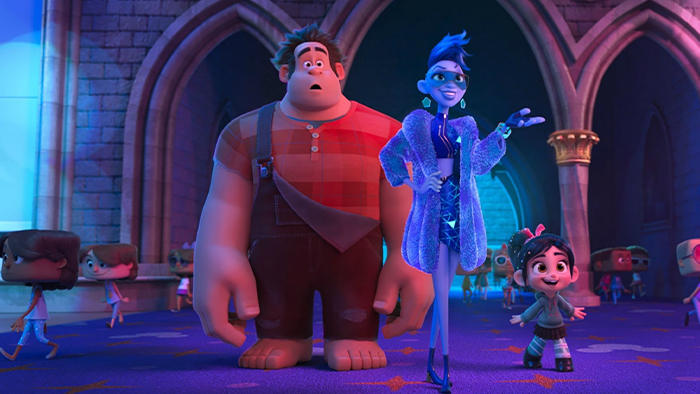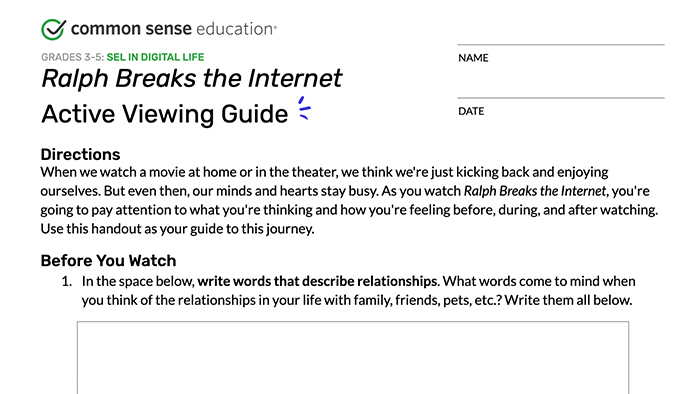Help students examine how relationships evolve and discuss digital citizenship topics.

Ralph Breaks the Internet is a sequel to Disney's Wreck-It Ralph. The first movie features Ralph struggling with his identity as a character in a video game. Along the way he becomes best friends with Vanellope von Schweetz, who's also struggling to accept herself, and specifically the fact that she glitches. By the end of Wreck-It Ralph, Vanellope accepts her glitch as an advantage and Ralph allows his friendship with Vanellope to evolve.
Though many kids will have seen the first movie, there's no need for them to in order to understand the sequel. Building on the first movie, Ralph Breaks the Internet shows Ralph and Vanellope's friendship in flux as they struggle with their different needs. Running alongside this core plot is a rich exploration of the digital world. While it's mostly played for laughs, those moments offer great opportunities to discuss very real topics we all encounter when we go online.
Things to Know About This Guide:
This guide offers two different approaches to teaching Ralph Breaks the Internet:
- Show a few specific clips paired with discussion questions.
- Show the entire film paired with a more in-depth lesson plan.
Feel free to use either approach, or even combine the two into one lesson (or an entire unit) based around the movie. If you only have a single class period, showing just a few key clips below might be perfect. If you decide to help students delve deeper into the topic, you might show the entire film and have more extensive discussions over multiple days. Of course, you could also use some combination of the two, adapting the lesson to best suit your class's needs. Use the Active Viewing Guide if it fits your needs.
Lesson Objectives

The full lesson is designed to align with the CASEL 5 competencies for social and emotional learning, as well as various thinking routines from the Harvard Graduate School of Education's Project Zero.
With this lesson, you can help your students:
- Identify their own feelings.
- Demonstrate honesty and integrity.
- Develop interests and a sense of purpose.
- Adopt a growth mindset.
- Negotiate conflict constructively.
- Seek or offer support and help when needed.
- Connect their own personal experiences with the movie's messages.
- Identify their own perspective, and be curious about the perspectives of others.
- Think about the ways they currently self-regulate, and explore possibilities for other ways.
- Think about helpful versus unhelpful responses to emotions from within themselves and from others.
This lesson also explores the six core topics addressed in our Digital Citizenship Curriculum. Many clips are labeled with abbreviations of our six digital citizenship topics, and some are linked to applicable lessons. The abbreviations below can help you focus on specific digital citizenship topics if you wish.
MB = Media Balance
P&S = Privacy & Security
R&C = Relationships & Communication
DF&I = Digital Footprint & Identity
CD&HS = Cyberbullying, Drama & Hate Speech
N&ML = News & Media Literacy
Ralph Breaks the Internet Clips and Discussion Questions for Student

If you only want to show brief parts of the film and discuss them with students, use these helpful clips to get you started. You can also use these in conjunction with the longer lesson plan below.
The time stamps can help you pick and choose your areas of focus. Use as few or as many clips as you see fit, but keep in mind that you may need to introduce the movie's overall plot and talk through some of what happens before or after each clip.
Clip #1: Wi-Fi is installed at the arcade and is made off-limits. (4:34–5:18) - P&S, MB
- Ask students: Why is Wi-Fi made off-limits in the arcade? If someone were about to use the internet for the first time, what guidance would you give them?
Clip #2: Vanellope wishes there was a new racing game. Ralph doesn't understand why she wants "something new and different." (5:19–6:03)
- It can be hard to disagree with a close friend. Ask students: What do you do when you and a close friend don't agree about something?
Clip #3: As two girls play Vanellope's game, Ralph tries to make it more exciting by creating a new track, which breaks the game. (6:50–10:55)
- Sometimes we do things that are meant to be nice, or that we think are the "right" thing, but they make things worse. While some things might just be outside of our control, there are also times when we need to reflect on our actions. Ask students: Are there times when "helping" might backfire? What are some examples, and what makes them not helpful?
Clip #4: Vanellope is feeling upset about her game being unplugged, and Ralph doesn't get it. Vanellope mentions they can "agree to disagree." (11:02–12:47)
- Vanellope says that she'll miss the "not knowing what's coming next" feeling, and, "If I'm not a racer, what am I?" Ask students: What is she feeling? Why does Ralph's idea of paradise—doing nothing all day—not appeal to her?
- What does it mean to "agree to disagree"? What are the pros and cons of telling someone this?
- Ralph and Vanellope both have a sense of identity and purpose: Vanellope is a racer who likes challenge and variety, and Ralph is a dependable friend who likes routine. Tell students: Take a few minutes to free-write about your identity and purpose. (Since this is a big topic, you can simplify with a prompt like, "I am a ___________ and a _________ who loves ___________ and finds meaning in ______________.")
Clip #5: Ralph and Vanellope head to the internet to find eBay. (16:59–21:03) - P&S, N&ML
- Creating strong passwords is important. Ask students: What do you think of "Highsc0re," the password Mr. Litwak creates? How could he make it stronger?
- Ask students: Why do you think we see brand names/logos like Snapchat, Amazon, Fandango, etc. in the movie? Can you explain "product placement"? How do these partnerships work? (You can use the linked article to talk about movies and product partnerships.)
Clip #6: Ralph and Vanellope seek help at the KnowsMore search counter. (21:32–23:04) - P&S, DF&I
- KnowsMore says he hopes little Madeline will do ballet longer than soccer. Ask students: How does KnowsMore know Madeline's name and what she did before? How is that also like real life?
- KnowsMore mentions "autofill." Ask students: What is autofill, and how do you think it works?
Clip #7: Ralph and Vanellope arrive at eBay. (23:45–24:18) - N&ML
- Ralph wants to stay focused, but he gets interrupted. Ask students: What's interrupting Ralph? Do you know of a way to avoid that kind of distraction?
Clip #8: Ralph and Vanellope find the steering wheel and bid the highest, but they don't have money to pay. (24:22–27:30)
- Ralph and Vanellope have no idea what shouting out numbers actually means. Ask students: Can you think of real-life scenarios where you might spend money without realizing it? (Here's one.)
Clip #9: Faced with needing to earn real money, Ralph and Vanellope remember the ad about playing video games to earn money. (28:11–31:23) - N&ML
- Ask students: If you saw an ad online to earn money fast, what would you think or do? Why?
- What internet references/jokes did you notice in this clip? (Spamly, antivirus, it's creepy and unpolished, loot hunting.)
Clip #10: Ralph and Vanellope visit Slaughter Race to steal Shank's car and make money via loot hunting. Vanellope almost succeeds, but Shank decides to help them make money another way. (39:40–41:24) - P&S, DF&I, and this lesson
- Shank suggests they use viral videos to make money and tells them her friend "Yesss" is an algorithm at BuzzTube. Ask students: What's an algorithm, and what is it for?
- Deeper discussion: What role do algorithms play in our lives? What influence do they have? What consequences—positive and negative—do we see?
Clip #11: After leaving Slaughter Race, Ralph and Vanellope have different feelings about the experience, about Shank, and what to do next. (41:39–42:57)
- Vanellope thinks Shank is really cool, which makes Ralph jealous. Ask students: We know it's possible to be friends with more than one person, so why would this situation make someone jealous?
Clip #12: Ralph and Vanellope visit BuzzTube and see Ralph's video getting likes. (42:57–51:26) - N&ML
- BuzzTube and YouTube are clearly similar, but likes on YouTube don't automatically convert to real money. Ask students: How do people actually make money on YouTube? How about on TikTok? Instagram?
- Ask students: What are some reasons Ralph goes viral? Does "going viral" mean the video is "good"? In real life, why might certain posts or content get lots of likes online?
- Discuss: Ralph is worried about him and Vanellope being apart—why?
Clip #13: Ralph suggests that Vanellope should use her pop-up ad in the Disney-focused area. (52:00–58:02) - DF&I, N&ML
- Ask students: Why do you think they featured a Disney/Pixar area in this movie?
- Vanellope hides in a room full of Disney princesses. The princesses ask Vanellope if people assume her problems always get solved by a "big, strong man." Ask students: Why do you think the princesses ask Vanellope this (given patterns in animated movies of the past)? What movies show girls or women being saved by men? What is this scene making fun of?
Clip #14: As Ralph desperately tries to get more hearts—and more money—he enters the comments section for videos. (59:39–1:01:49) - CD&HS
- Ask students: Why does Yesss say, "First rule of the internet: Do not read the comments"?
- Discuss: What does Yesss mean when she says, "It's not about you; it's about them"?
- To make himself feel better, Ralph thinks about his "irl" (in real life) friend, Vanellope. Ask students: In addition to focusing on people who truly know you, what are some other ways to deal with all of the meanness and negativity online?
- Ralph makes over $30,000 in one day with viral videos. Challenge students to find out how long it really takes to make that much money on different platforms—and how many hours of work.
Clip #15: After Ralph finds out they have enough money, he tells Vanellope, "Our lives can finally get back to normal." (1:02:25–1:06:16)
- Vanellope isn't nearly as excited as Ralph about life getting back to normal. Ask students: Why isn't she excited? What does "normal" mean to her? What does it mean to Ralph?
- During the height of the pandemic, people sometimes talked about things getting back to "normal." Discuss: What did that mean then? Does "normal" mean the same thing now?
- Discuss: We've also been through quite a journey through the unknown during the past couple of years. Is there anything you've learned about yourself?
Clip #16: When Ralph calls Vanellope, he overhears a conversation between her and Shank. (1:06:17–1:09:43)
- Ask students: Do you agree or disagree with Shank about best friends not having to have the same dreams? Why?
- Ralph says Slaughter Race isn't good for Vanellope, and he wants to infect it with a virus so she won't want to stay there. Ask students: How is it that we can love someone and still do something that might make them unhappy?
Clip #17: Vanellope hasn't told Ralph she's planning on staying in Slaughter Race, and Shank encourages her to tell him. (1:12:31–1:13:38)
- Telling someone something that we're pretty sure will upset them is really hard. Shank acknowledges that Ralph might get really upset. Ask students: Do you think there's a way to totally avoid making loved ones upset?
- When friendships change, it can be painful. Shank says the best friendships can get stronger through changes. Ask students (and tell them they can write responses if they don't want to share aloud): What is their experience with changing friendships? How have they handled it?
Clip #18: After the virus latches onto Vanellope's glitch, Ralph gets her out before the game reboots. Vanellope and Ralph argue, and the virus latches onto Ralph's literal insecurity. (1:16:40–1:19:09)
- Ralph and Vanellope end up fighting. Discuss: What feelings are underneath their angry words? What could they do that might help them resolve the argument?
- The virus latches onto and copies "insecurities." Why does it focus on Ralph?
Clip #19: Vanellope takes shelter in the KnowsMore kiosk and Ralph finds her. (1:20:16–1:23:00) - P&S, R&C
- The Wreck-It Ralph virus is described as a "denial of service attack." As a class, find out what that is and how it can happen.
- KnowsMore says the virus is Ralph's neediness come to life. In real life, this might mean constantly texting a friend and expecting responses right away. Ask students: What should we do if we're texting someone and they're not answering? What can we do if someone is texting us too much and we don't want to hurt their feelings?
Clip #20: The virus versions of Ralph combine to become one big Ralph. Ralph says he has "a date with the man in the mirror." (1:24:52–1:30:45)
- To defeat the insecure part of himself that got out of control, Ralph needs to reassure it. Discuss: We all have insecure/less-than-ideal parts of ourselves, so how can we deal with them?
Clip #21: Vanellope and Ralph sit in front of Slaughter Race and talk. (1:32:49–1:35:28 ) - MB
- Ralph mentions that the sun never rises or sets in the internet because it's "always on." Discuss: What are the advantages and disadvantages of this? Since it's always on, it can be hard to stop scrolling/playing/etc. How do you know when enough is enough? How do you stop?
- Sometimes emotions can be complicated. How would you describe all of the feelings they're having in this clip?
Clip #22: Though things are different, Ralph and Vanellope maintain their friendship. (1:35:23–end)
- Ask students: What are some ways Ralph and Vanellope maintain their friendship? How does technology play a role in that? What are some ways tech can connect people?
Ralph Breaks the Internet Lesson Plan and Graphic Organizer

Begin by introducing the movie and giving students some context about why it's worth thinking about more deeply. A lot of students may have seen the movie already, so make a strict "If you know it, don't blow it" rule to prevent spoilers. You might also want to discuss some of the learning objectives or the concept of active viewing.
Before the Movie
Hand out copies of the Active Viewing Guide, and give students a few minutes to finish the Before You Watch question.
- Students will be listing words to describe relationships. It's essential that students do both the first and last questions on the handout to fully round out the discussion.
- For a more interactive experience, you can have kids create a "relationships" word cloud using a tool of your choice.
Before you start the movie, explain the next activity that students will complete while they watch. They'll need to pick out visual representations of the internet/being online and sketch or describe them.
During the Movie
Make sure to pause periodically at key scenes throughout the movie (feel free to use the clips outlined above in this article). As you pause and discuss, give students time to do some writing/sketching.
After the Movie
Have students complete the After You Watch activities.
- Students can write down their responses individually, then discuss in pairs, small groups, and/or as a whole class.
Discussion Questions:
After the movie ends, it's important to help students reflect on what they've seen and talk about what they're thinking. You can discuss anything that feels particularly relevant to your students. The scenes and discussion questions listed earlier in this article can be a good starting point, but feel free to guide your class discussion as you see fit.
Creative Extensions
- Have kids create a visual representation of the internet, how Wi-Fi works, or different parts of either.
- Writing or drawing prompt: If an insecurity virus focused on you, what would it create?
- Watch another movie with similar themes.
- The Mitchells vs. The Machines
- Ron's Gone Wrong
- Ready Player One (for older students)
Invite students to consider how these movies present the issues of digital life and relationships online (and offline). Each of the films tells a story about the ups and downs of connecting with others. Whether it's Ralph and Vanellope learning about themselves on the internet, the Mitchells surviving as a family during technological apocalypse, Ron befriending a robot, or Wade and his friends escaping the real world to fight an evil tech company in VR, all of these films show us the importance of relationships on and off the internet.







